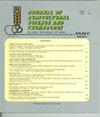湖南大棚瓜类丝瓜属植物的发生与分布
IF 1.3
4区 农林科学
Q2 AGRICULTURE, MULTIDISCIPLINARY
引用次数: 0
摘要
2013年5月至10月,对全罗南道和全罗北道主要栽培地区的5种瓜类进行了调查,目的是根据区域作物(cid:57267),建立温室作物中丝瓜病发生和分布的D/B,并将其作为选育抗丝瓜病品种和轮作作物等害虫防治的数据。调查结果显示,黄瓜50%、甜瓜31.3%、西瓜26.7%、西葫芦30%、甜瓜18.2%发生侵染。在全罗北道金济地区,黄瓜中被害最严重,幼虫密度平均为1999只/ 100 (cid:62594)(cid:71)土壤单位。根据PCR鉴定结果,共鉴定出2种Meloidogyne sp .,按幼虫密度排列顺序为:M. incognita (cid:59577) M. arenaria;本文章由计算机程序翻译,如有差异,请以英文原文为准。
The Occurrence and Distribution of Meloidogyne spp. of Cucurbits in Greenhouse, Honam Province
Five species of cucurbits from major cultivation areas in Jeollanam-do and Jeollabuk-do have been investigated from May to October 2013 in order to create D/B on the occurrence and distribution of Meloidogyne spp. occurring in greenhouse-grown crops according to region (cid:57267) crop, and in order to utilize it as data for pest control, such as the selection of cultivar resistant to Meloidogyne spp., and rotation crop. According to the results of investigation, 50% of cucumber, 31.3% of melon, 26.7% of watermelon, 30% of squash and 18.2% of melon were infected. In cucumber, there was the most severe damage of Meloidogyne spp. in Gimje region, Jeollabuk-do, and the larval density was an average of 1,999 per 100 (cid:62594)(cid:71) soil unit. According to the results of species identification using PCR, the investigation showed that 2 species of Meloidogyne spp. were identified, and they were arranged in the following order of larval density: M. incognita (cid:59577) M. arenaria.
求助全文
通过发布文献求助,成功后即可免费获取论文全文。
去求助
来源期刊

Journal of Agricultural Science and Technology
AGRICULTURE, MULTIDISCIPLINARY-
CiteScore
1.90
自引率
8.30%
发文量
0
审稿时长
4.5 months
期刊介绍:
Journal of Agricultural Science and Technology is one of the TMU Press journals that is published by the responsibility of its Editor-in-Chief and Editorial Board in the determined scopes.
Journal of Agricultural Science and Technology (JAST) is an international research journal published bimonthly for the purpose of advancing the scientific studies. The subjects covered by JAST include all aspects of agriculture and natural resources (see Areas Covered). The journal will consider submissions from all over the world, on research works not being published or submitted for publication towards publication as full paper, review article and research note. The Papers are published in English with an extra abstract in Persian.
 求助内容:
求助内容: 应助结果提醒方式:
应助结果提醒方式:


